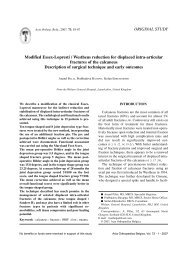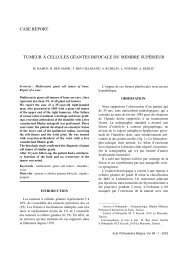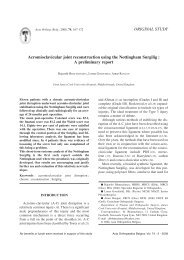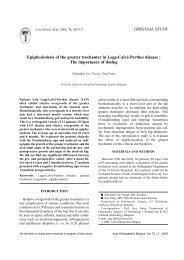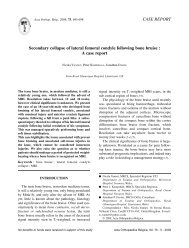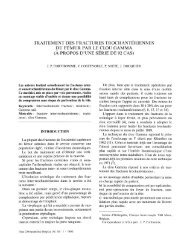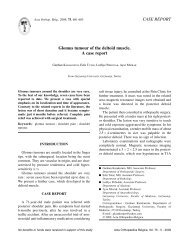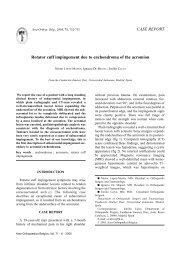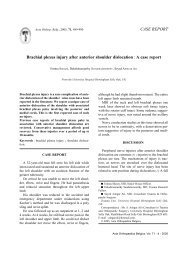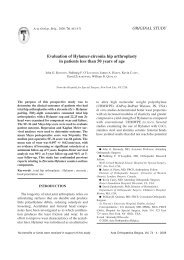Functional reconstruction of the upper extremity in tetraplegia ...
Functional reconstruction of the upper extremity in tetraplegia ...
Functional reconstruction of the upper extremity in tetraplegia ...
You also want an ePaper? Increase the reach of your titles
YUMPU automatically turns print PDFs into web optimized ePapers that Google loves.
544 D. WELRAEDS, A. A. ISMAIL, A. PARENT<br />
Former-Cordero et al <strong>in</strong> 2003 (6) evaluated 66<br />
operated cases us<strong>in</strong>g <strong>the</strong> questionnaire <strong>of</strong> Lamb and<br />
Chan on daily liv<strong>in</strong>g activ i t i e s , m o d i fied by<br />
Mohamed. This questionnaire is subjective, mix<strong>in</strong>g<br />
functional and psychosocial items <strong>of</strong> unequal<br />
i m p o rt a n c e, re n d e r<strong>in</strong>g its pert<strong>in</strong>ence doubtful.<br />
Hentz (10) shares a similar reservation towards<br />
functional tests is : he f<strong>in</strong>ds functional evaluation<br />
useless except for simple measurements <strong>of</strong> strength<br />
and amplitude. Already <strong>in</strong> 1948, Bunnell (3) stated<br />
that, on account <strong>of</strong> <strong>the</strong> amount <strong>of</strong> variables, it is<br />
impossible to evaluate statistically <strong>the</strong> results <strong>of</strong><br />
tendon <strong>reconstruction</strong>.<br />
All our patients have at least been submitted to a<br />
cl<strong>in</strong>ical and functional exam<strong>in</strong>ation pre- and postoperatively<br />
<strong>in</strong> order to achieve a standard qualitative,<br />
if not quantitative assessment <strong>of</strong> <strong>the</strong> results.<br />
For this purpose we used :<br />
– ei<strong>the</strong>r <strong>the</strong> Highet scale for assess<strong>in</strong>g muscular<br />
s t re n g t h , adopted by <strong>the</strong> Medical Research<br />
Council <strong>in</strong> 1974, advocated by Möberg and<br />
applied to muscular groups contribut<strong>in</strong>g to one<br />
function,<br />
– or a few simple functional tests like tak<strong>in</strong>g a pen,<br />
a matchbox, a telephone receiver.<br />
Value <strong>of</strong> electrophysiological assessment.<br />
Electrophysiological test<strong>in</strong>g is usually omitted <strong>in</strong><br />
pre-operative assessment. However, with medicolegal<br />
issues <strong>in</strong> m<strong>in</strong>d, we found it useful to produce an<br />
objective appraisal <strong>of</strong> <strong>the</strong> muscular status (ra<strong>the</strong>r<br />
more qualitative than quantitative).However this<br />
method is unable to give any <strong>in</strong>formation on muscle<br />
strength and Möberg (17) <strong>the</strong>refore preferred<br />
b i o fe e d b a ck for this purp o s e. We also used<br />
bi<strong>of</strong>eedback techniques but solely for rehabilitation<br />
purposes : this method provides ocular and auditive<br />
signals to <strong>the</strong> patient and accelerates efficient corticalisation<br />
<strong>of</strong> <strong>the</strong> transfer.<br />
RESULTS<br />
Results must be objectively assessed <strong>in</strong> terms <strong>of</strong><br />
analytical ga<strong>in</strong> (strength, amplitude), functional<br />
ga<strong>in</strong> (autonomy), or quality <strong>of</strong> life.<br />
The diversity <strong>of</strong> <strong>the</strong> cl<strong>in</strong>ical situations and <strong>the</strong><br />
c o rrespond<strong>in</strong>g surgical <strong>in</strong>terve n t i o n s , and <strong>the</strong><br />
weakness <strong>of</strong> <strong>the</strong> evaluation methods do not allow<br />
an objective quantitated analysis.<br />
This obstacle <strong>in</strong> tendon <strong>reconstruction</strong> surgery<br />
was noted by Bunnell (3) <strong>in</strong> 1948 and later confirmed<br />
by Hentz (10) <strong>in</strong> 1983.<br />
In a study targeted on simple deltoid/triceps<br />
transfer, Dunkerly et al (4) admitted <strong>the</strong>y were<br />
u n able to demonstrate any diffe rence betwe e n<br />
operated tetraplegics and non-operated controls,<br />
although <strong>the</strong> operated cases said <strong>the</strong>y were functionally<br />
improved.<br />
Allieu et al (1) studied <strong>the</strong> results <strong>of</strong> restoration<br />
<strong>of</strong> elbow extension with <strong>the</strong> posterior deltoid <strong>in</strong><br />
11 cases ; <strong>the</strong>y noted that <strong>the</strong> mean strength <strong>of</strong><br />
extension amounted to 27 % <strong>of</strong> that <strong>in</strong> normal<br />
subjects.<br />
We also found <strong>the</strong>se mixed results <strong>in</strong> our<br />
strength rat<strong>in</strong>gs ; <strong>the</strong> deltoid course is too short to<br />
give an important extension strength but this ga<strong>in</strong><br />
obta<strong>in</strong>ed enlarges prehension space, and provides a<br />
functional improvement as described by Allieu et<br />
al (2).<br />
In hand <strong>reconstruction</strong>, Vanden Berghe et al (20)<br />
used Jamar’s dynamometer and simple functional<br />
tests to quantify <strong>the</strong>ir results : <strong>the</strong>y noted some ga<strong>in</strong><br />
<strong>in</strong> all patients at least <strong>in</strong> strength (grasp, key grip,<br />
wrist extension).<br />
In s<strong>in</strong>gle procedures as well an <strong>in</strong> multiple procedures,<br />
we rated our results as “good” <strong>in</strong> 22 cases<br />
out <strong>of</strong> 23 (“good” = an effective function with<br />
noticeable ga<strong>in</strong> regard<strong>in</strong>g <strong>the</strong> function which was<br />
absent pre-operatively).<br />
Former-Cordero et al (6) analysed <strong>the</strong>ir results<br />
from a functional standpo<strong>in</strong>t (performance <strong>in</strong> daily<br />
liv<strong>in</strong>g activities) ; <strong>of</strong> 20 cases, 3 were rated excellent<br />
and 9 medium to good. Likewise, Möberg<br />
states that 75 % <strong>of</strong> quadriplegics can be improved<br />
by surgery (16)<br />
This “satisfy<strong>in</strong>g” quality <strong>of</strong> <strong>the</strong> results is also found<br />
to some degree <strong>in</strong> o<strong>the</strong>r studies (5,10,12).<br />
CONCLUSIONS<br />
We conducted a prospective study <strong>of</strong> 43 operations<br />
for restoration <strong>of</strong> function <strong>of</strong> <strong>the</strong> <strong>upper</strong> limb <strong>in</strong><br />
Acta Orthopædica Belgica, Vol. 69 -6-2003



